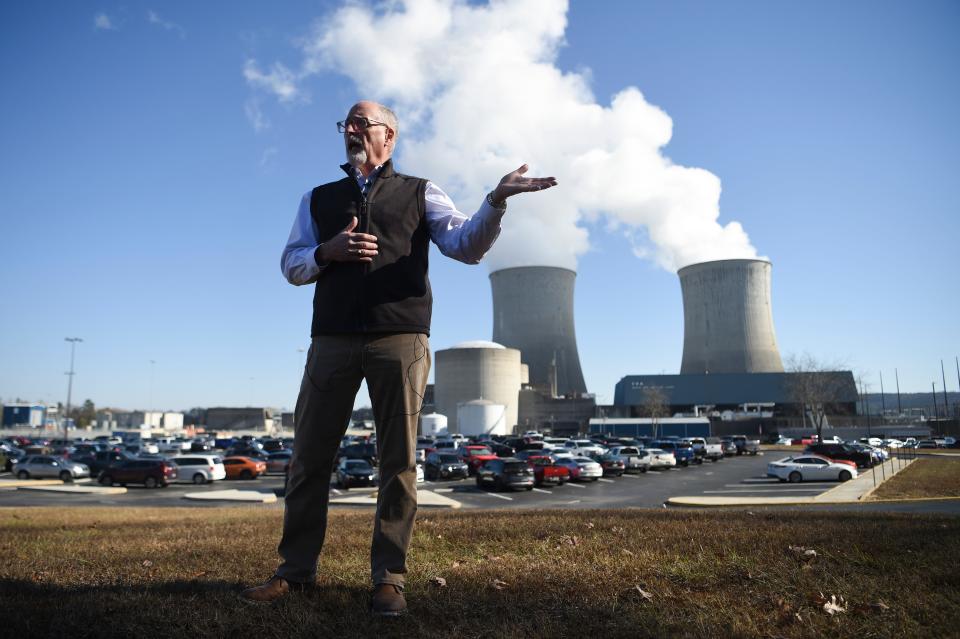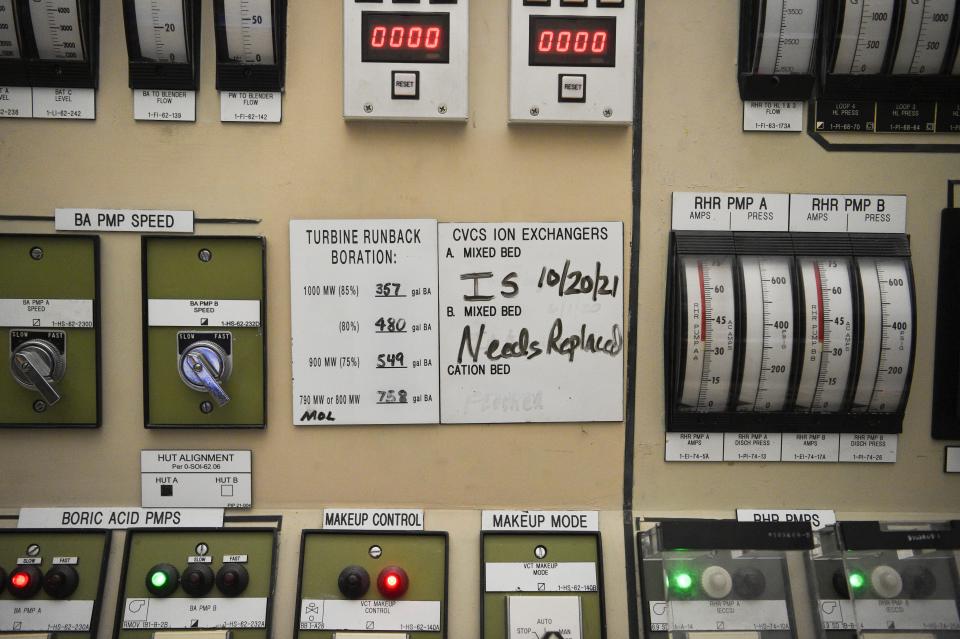How do TVA's nuclear plants prepare for emergencies? | Know Your Knox
The most enduring image of a nuclear operator in American media is Homer Simpson, fallen into a jelly doughnut-induced coma while warning sirens blare at the fictional Springfield Nuclear Power Plant.
Fortunately, the reality at Tennessee's two nuclear plants could hardly be more different.
Nuclear operators at the Tennessee Valley Authority spend about a fifth of their work hours in training, whether it's in an on-site simulator or in a classroom. That's after the two years of training it takes to get their license in the first place.
No matter how experienced their staff, TVA and the Tennessee Emergency Management Agency have to be vigilant and lifelong students of nuclear safety.
Every two years, federal regulators come to East Tennessee to grade a full-scale emergency response drill at TVA's Sequoyah and Watts Bar nuclear plants, which together supply around 45% of Tennessee's electricity.
The plants have always passed the tests. If they didn't, TVA's nuclear operating license would be on the line. During the drills, TVA, which relies on nuclear for 42% of power generation across its system, is graded by the Nuclear Regulatory Commission.
The Tennessee Emergency Management Agency, which is responsible for any emergency that escapes the nuclear plants, is graded by its federal counterpart, the Federal Emergency Management Agency.
These protocols, along with the thick containment structures around the fuel core that keep radiation from escaping, undergird an industry that has suffered a few high-profile accidents.
Some accidents have been fatal and disastrous, like Chernobyl in 1986 and Fukushima in 2011. Others have simply caused widespread alarm, like one at Pennsylvania's Three Mile Island plant in 1979, the last nuclear accident in the U.S.
All accidents lead to crises in public faith and safety updates across the global nuclear industry.

Then there are the unflattering media depictions of nuclear safety, from "The Simpsons" to the panicked nuclear operators shocked by a tripped reactor in the 1979 disaster flick "The China Syndrome," released just 12 days before a partial meltdown at the Three Mile Island plant.
That timing was fortuitous for the film industry and scary for the nuclear industry, said Mike White, emergency preparedness manager at Watts Bar.
“I think it really portrayed the operators in a pretty poor light. When they have the reactor trip, everybody’s like, ‘Oh my God, we don’t know what to do,’" White said on a tour of Watts Bar's training center. "When those alarms start going off and the buzzers start going on, everybody in here knows exactly what to do and they’re very calm.”
There are four levels of emergency in the nuclear industry: a Notification of Unusual Event, an Alert, a Site-Area Emergency and a General Emergency. Watts Bar has never declared anything above Notification of Unusual Event, the lowest level, White said.
Nuclear operators are trained to identify and classify any emergency and report it to the state within 15 minutes. When plant staff thought there might be a fire at Watts Bar in October, it took them more than 15 minutes to discern if there actually was a fire, so the state was notified of a possible unusual event. It ended up that there was no fire.
In addition to the full-scale federal drills every other year, Watts Bar conducts four annual drills on-site to make sure its staff are prepared for any situation.

TVA sends annual safety calendar to residents
Federal regulators require TVA to give updated evacuation and safety information to residents within 10 miles of its plants. At Watts Bar, located on the border of Meigs and Rhea counties, the agency sends out a safety calendar each year in coordination with the Tennessee Emergency Management Agency and county agencies to the 15,000 residents in the 10-mile Emergency Planning Zone.
The calendar informs residents of the radio and TV stations they should tune into for emergency alerts and the safety precautions they should take in the highly unlikely event that a plume of radiation makes it way out of the plant.
It also shows evacuation routes and explains how kids in school would be relocated to schools farther away. It tells farmers and gardeners how to handle plants exposed to radiation and shows dates for when sirens will be tested on the first Wednesday of every month.
The calendar also explains in an accessible way how nuclear plants work, and it doesn't shy from addressing the public's fears, some of which aren't possible.
"It is physically IMPOSSIBLE for the nuclear fuel at Watts Bar to explode like a nuclear bomb," the calendar says, explaining that uranium fuel in the plant is much less enriched and concentrated than weapons-grade uranium.
If the plant's cooling system or pressure were compromised and radiation from its uranium fuel escaped three layers of containment, residents within 10 miles could be directly exposed to radiation, White said. That's where shelter-in-place or evacuation orders may be given.
Residents between 10 and 50 miles away would not be directly exposed, but could be at risk of ingesting radioactive material.
Knoxville is 65 miles from Watts Bar, so a nuclear emergency at the plant would not directly harm the city. That's not the case for Chattanooga, which sits just 20 miles from the Sequoyah Nuclear Plant.
How well do you Know Your Knox? We answer the questions you really want to know
Still, no large nuclear accident has occurred in the U.S. since Three Mile Island, which did not kill anyone and exposed the surrounding public to less radiation than an X-ray machine produces, according to the Nuclear Regulatory Commission.
When each TVA unit shuts down to partially refuel every 18 months, hundreds of people perform thousands of maintenance activities to make sure the plants are running safely. Watts Bar Unit 2 finished its latest refueling in November and crews finished 10,000 maintenance tasks, TVA said.
TVA nuclear plants have two of almost everything
In a simulation of its main operating system at Watts Bar, TVA nuclear operator trainees get acquainted with close to 7,000 switches and indicators.
The room can simulate almost every kind of emergency situation, including an earthquake. At the push of a button, the overhead lights cut out and a loud rumbling sounds shakes the room. Operators must learn how to keep the system stable as the earth shakes beneath them.
Leon Neat, senior training operations manager, said training is a "never-ending" process that is constantly evolving as new potential problems arise.
“I’ve got backup systems for backup systems,” Neat said. “If one of them malfunctions, they’re in a casualty, you’re relying on another one. We will intentionally break stuff like that and make the operators respond to it. Sometimes, we’ll make both of them break so they have to go address it.”
Watts Bar Unit 2 came online in 2016, bringing enough power to the grid for 650,000 homes and becoming the first new nuclear generation of the 21st century.
TVA's nuclear fleet, composed of seven units across three plants, is the third largest in the nation and has enabled the agency to cut carbon emissions by around 60% since 2005.
Having two or more of every safety mechanism at Watts Bar protects that power, vital to TVA's goal of net-zero carbon emissions by 2050.
"Just about everything else is redundant," White said.
Know Your Knox answers your burning questions about life in Knoxville. Want your question answered? Email knowyourknox@knoxnews.com.
Daniel Dassow is a growth and development reporter focused on technology and energy. Phone 423-637-0878. Email daniel.dassow@knoxnews.com.
Support strong local journalism by subscribing at knoxnews.com/subscribe.
This article originally appeared on Knoxville News Sentinel: How TVA Watts Bar in East Tennessee prepares for nuclear emergency

